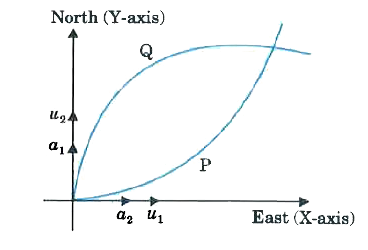Two paricles A and B start simultaneously from the same point and move in a horizontal plane. A has an initial velocity u1 due east and acceleration a1 due north. B has an intial velocity u2 due north and acceleration a2 due east.
Paths followed by the particles must intersect at a point
Particles must collide at a point
Particles will collide if a1u1=a2u2
Particles will attain same speed at some point of time if u1<u2anda1>a2
The correct Answer is:A, C, D
(a,c,d): Path for both the particles are shown in the figure . Initial velocity should be tangent to the path and path should curve according to the aceeleration . We can see that the paths followed by both the particles must intersect each other . Hence , option (a) is correct .

Topper's Solved these Questions
- BOOK - MODERN PUBLICATIONCHAPTER - MOTION IN A PLANE EXERCISE - COMPETITION FILE OBJECTIVE TYPE QUESTIONS (D. MULTIPLE CHOICE QUESTIONS)9videos
MOTION IN A PLANE
- BOOK - MODERN PUBLICATIONCHAPTER - MOTION IN A PLANE EXERCISE - COMPETITION FILE OBJECTIVE TYPE QUESTIONS (Assertion Reason Type Questions)10videos
MOTION IN A PLANE
- BOOK - MODERN PUBLICATIONCHAPTER - MOTION IN A PLANE EXERCISE - COMPETITION FILE OBJECTIVE TYPE QUESTIONS (JEE (Advanced) for IIT Entrance)2videos
MOTION IN A PLANE
- BOOK - MODERN PUBLICATIONCHAPTER - MECHANICAL PROPERTIES OF FLUIDSEXERCISE - Chapter Practise Test16videos
MECHANICAL PROPERTIES OF FLUIDS
- BOOK - MODERN PUBLICATIONCHAPTER - MOTION IN A STRAIGHT LINE EXERCISE - CHAPTER PRACTICE TEST16videos
MOTION IN A STRAIGHT LINE
Similar Questions
Knowledge Check
- Question 1 - Select One or More
Two particles A and B start simultaneously from the same point and move in a horizontal plane. A has an initial velocity u1 due east and acceleration a1 due north. B has an initial velocity u2 due north and acceleration a2 due east. Then :
AThey must collide at some pointBThey will collide only if a1u1=a2u2Ctheir paths must interesect at same pointDIf u1>u2 & a1<a2, the particles will have the same speed at some point - Question 2 - Select One
A particle has initial velocity of 17ms−1 towards east and constant acceleration of 2ms−2 due west. The distance covered by it in 9th second of motion is :
A0 mB0.5 mC72 mD2 m - Question 3 - Select One
A particle has an initial velocity of 5.5ms−1 due east and a constant acceleration of 1ms−2 due west. The distance covered by the particle in sixth second of its motion is.
A0B0.25 mC0.5 mD0.75 m
Two points P and Q move in a straight line AB. The point P starts from A in the direction AB with velocity u and acceleration f and at the same time Q starts from b in the direction of BA with velocity u1 and acceleration f1. If they pass one another at the middle point of AB and arrive at the other ends of AB with equal velocities, then (u+u1)(f−f1)=8(fu1−f1u).
View SolutionA body is simultaneously given two velocities, one 10ms−1 due east and other 20ms−1 due north-west. Calculate the resultant velocity.
View SolutionThe velocity of particle P due east is 4ms−1 and that of Q is 3ms−1 due north. What is the relative velocity of P w.r.t. Q.
View SolutionA man goes 24 m due east and then 10m due north.How far is he away from his initial position?
View SolutionA particle has an initial velocity of 9m/s due east and a constant acceleration of 2m/s2 due west. The displacement coverd by the particle in the fifth second of its motion is :
View Solution

